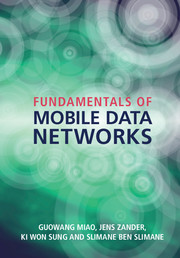Book contents
- Frontmatter
- Contents
- Preface
- Acronyms
- Notations
- 1 Introduction
- 2 Wireless network models
- 3 Medium access control
- 4 Scheduling
- 5 Principles of cellular systems
- 6 Transmitter power control
- 7 Interference management
- 8 Association and handover
- 9 Energy-efficient design
- 10 Long term evolution
- 11 Wireless infrastructure economics
- About the authors
- Index
Preface
Published online by Cambridge University Press: 05 March 2016
- Frontmatter
- Contents
- Preface
- Acronyms
- Notations
- 1 Introduction
- 2 Wireless network models
- 3 Medium access control
- 4 Scheduling
- 5 Principles of cellular systems
- 6 Transmitter power control
- 7 Interference management
- 8 Association and handover
- 9 Energy-efficient design
- 10 Long term evolution
- 11 Wireless infrastructure economics
- About the authors
- Index
Summary
The world has seen astonishing developments in wireless communications. From the early days when wireless was seen as a new and complex technology that required skilled operators to work, to a situation where wireless has become a truly pervasive technology with devices in everyone's pocket. Voice communications, including mobile telephony, have dominated the first century of wireless communications. The technical challenges have been dominated by the struggle of the engineer against nature—how to facilitate communications over long distances and how to overcome adverse radio propagation conditions. With the advent of digital communications, we have over recent decades seen marvelous advances in this area, with technologies such as error control coding, digital signal processing, advanced antenna technologies and others. Meanwhile, the number of wireless users has skyrocketed. In addition we now witness wireless Internet access becoming a dominant technology for all kinds of IT services. A necessary prerequisite for this development is that wireless access is abundant and becomes almost free. The consequence is that data rates in wireless communications have increased dramatically during the last decade. The industry predicts an exponential increase of data traffic that would correspond to a 1000-fold increase in traffic between 2010 and 2020. It has become obvious that traditional measures for increasing data rates in the wireless links, e.g. coding and signal processing, are not going to save the day since these techniques now operate close to their theoretical limits, regardless of their complexity. Instead, much of the focus of the engineering work has shifted to what can be seen as the social struggle for scarce resources. The proper management of resources such as frequency spectrum, energy consumption, and to a large extent monetary investments in infrastructure (base stations and the like) is now a key issue. The design objectives have changed from “how can we provide high quality communications in a single radio link?” to “how can we create sustainable systems that provide affordable high quality wireless communications for billions of users?” The latter question is mainly one of Radio Resource Management (RRM), which is the main theme of this book. The book approaches this problem in the following way.
- Type
- Chapter
- Information
- Fundamentals of Mobile Data Networks , pp. x - xiPublisher: Cambridge University PressPrint publication year: 2016



